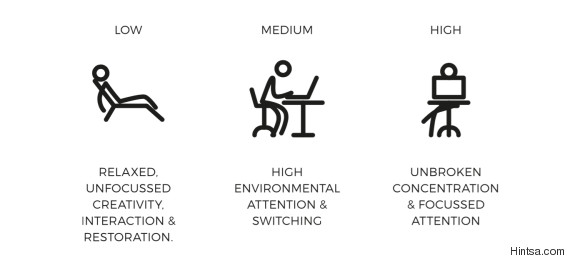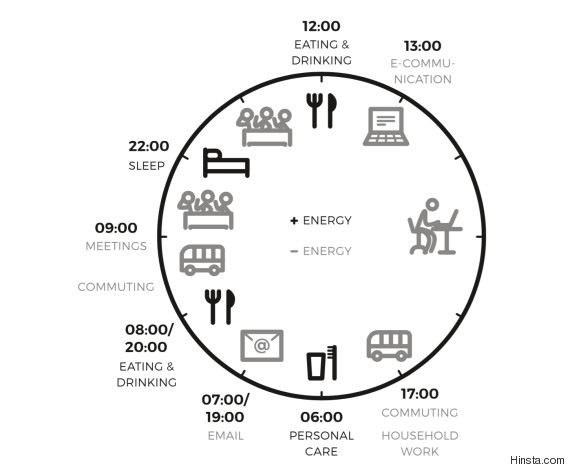Let’s consider the work cycle of Jing – a hypothetical manager based in a typical multinational business. She gets out of bed at 6:30am and, like four in five of us, checks her smartphone within 15 minutes of waking. She makes herself breakfast and spends half-an-hour scanning her phone and checking e-mail. On average, Jing, like most people, spreads six hours of e-mail use over each day.
At 8am, she gets in her car for the commute to work (she’s not among the 18% of workers who admit to checking their e-mail while driving) and spends the rest of her morning in meetings, during which she’s checking her phone and pretending to write notes on her laptop (92% of workers admit to multi-tasking during meetings).
Jing’s afternoon is dominated by interweaving tasks, mainly phone calls, e-mails, instant messages and social media. Mixed into this digital concoction are the other distractions of the open office: gossip, snack breaks and noisy co-workers.
She leaves the office at 5:30pm and does a few jobs around the house, has an evening meal, then enjoys three hours of leisure time. As 70% of people do, she checks her e-mail while watching TV, spending most of her ‘down-time’ switching constantly between screens: the TV, smartphone and tablet.
After checking her phone for the final time (she’s now at a tally of 149 for the day), she tries to fall asleep, but the blue light from her late-night screen time has suppressed her melatonin production by 22%.
If you consider Jing’s day from the perspective of cognitive work, she is faced with three key challenges:
1) Time pressure: How much of her time was actually focused on an activity?
2) Switches: How often did she have to switch from one thing to the other?
3) Complexity: How complex, or routine, were the tasks that Jing had to deal with?
Thinking in terms of cognitive gears

These three questions give us a sense of the overall cognitive load for a given time-period. You can think about this cumulative load as three different ‘cognitive gears.’ We can use them as a quick and simple way to plan and reflect on the allocation of cognitive resources, and distributing cognitive work through the day.
Like most of the knowledge workers I speak to, Jing spent most her day stuck in cognitive middle-gear, in a state of constant partial attention. Very little time was spent in low gear, and a fraction was invested in a focused and intense high gear. We can all relate to this in our daily lives, but how do we combat it?
Winning by slowing down

Top-performers, in sport and in business, appear to distribute their cognitive and physical efforts in periods of high-intensity and focus, followed by periods of effective recovery and regeneration. This approach allows them to focus on what’s most important and maximise their development and output, sustainably.
Many of us would profit from creating the same distinct periods in our day-to-day lives. This ‘polarised’ approach ‘rescues’ time – thanks to reduced task-switching – reduces stress and facilitates better progress on tasks with strategic and long-term significance. We also get to enjoy more creative down-time, and better recovery.
In practice, a ‘polarised’ day could look something like this:
• Low Gear: Relaxation and recovery (low complexity, low switching)
Protect this time by avoiding distractions (switching) and pseudo-work (social media, etc.) It’s possible to enter ‘low gear’ in brief periods through the day, but this should also take place over longer periods, usually during the evening.
• Medium Gear: Routine and quick tasks (medium complexity, higher switching)
Some switching is inevitable. You are likely to be able to complete the medium-gear tasks, such reading and replying to most e-mails quite quickly as the work is not too complex. Complex issues should be avoided during ‘middle gear’ switching periods, as it’s much easier to make mistakes. Schedule separate time for the complex issues you discover while working in this gear.
• High Gear: Focussed and demanding tasks (High complexity, low switching)
Reserve longer periods for deep focus, to allocate cognitive resources to the complexity of the task, rather than wasting it on switching or because of time pressure. Switching tasks should be avoided to maintain focus and reduce unnecessary cognitive load.
We could all benefit from considering how we are distributing our cognitive load. In particular, what we are paying attention to and where we are investing our energy and time. If we learn from our findings, the effect on our wellbeing and performance could be exponential.
This article was first published on UNLIMITED.
— This feed and its contents are the property of The Huffington Post UK, and use is subject to our terms. It may be used for personal consumption, but may not be distributed on a website.